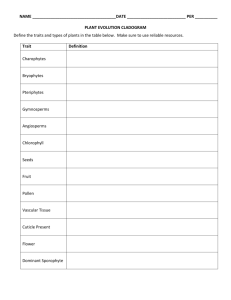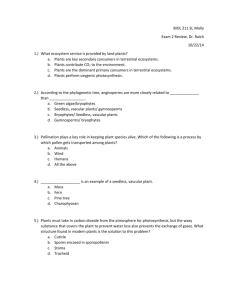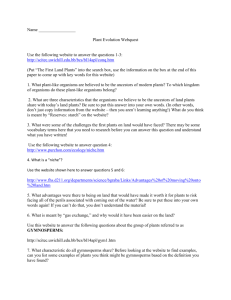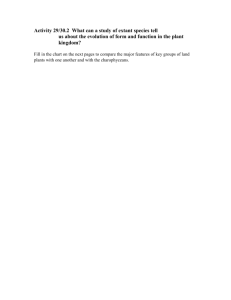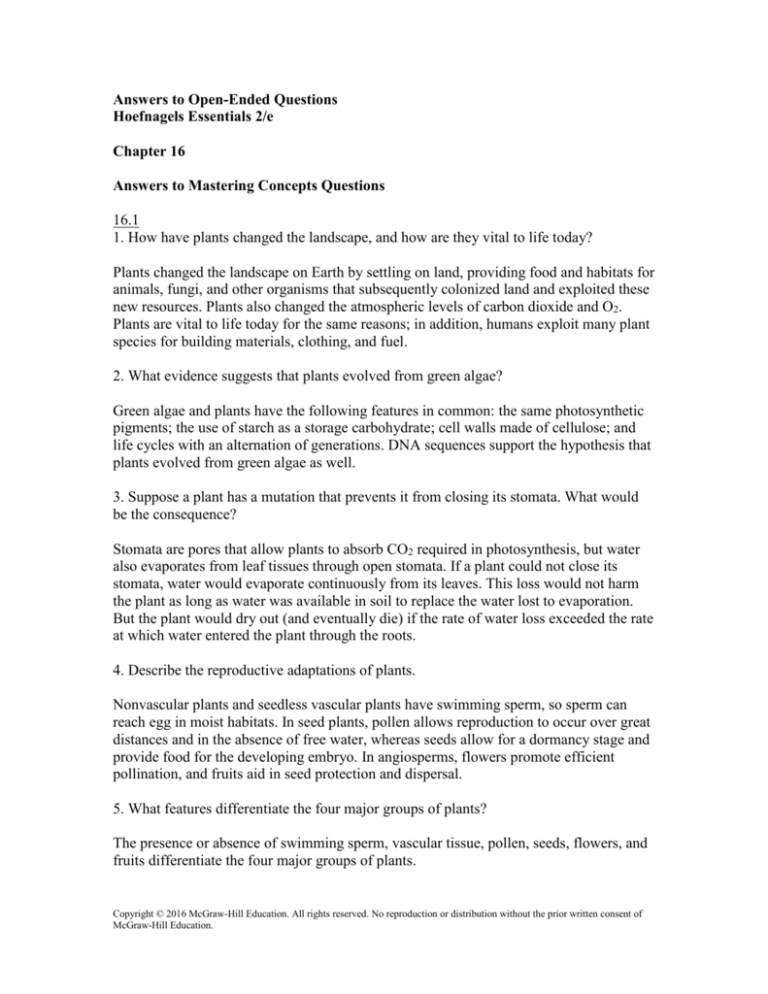
Answers to Open-Ended Questions
Hoefnagels Essentials 2/e
Chapter 16
Answers to Mastering Concepts Questions
16.1
1. How have plants changed the landscape, and how are they vital to life today?
Plants changed the landscape on Earth by settling on land, providing food and habitats for
animals, fungi, and other organisms that subsequently colonized land and exploited these
new resources. Plants also changed the atmospheric levels of carbon dioxide and O2.
Plants are vital to life today for the same reasons; in addition, humans exploit many plant
species for building materials, clothing, and fuel.
2. What evidence suggests that plants evolved from green algae?
Green algae and plants have the following features in common: the same photosynthetic
pigments; the use of starch as a storage carbohydrate; cell walls made of cellulose; and
life cycles with an alternation of generations. DNA sequences support the hypothesis that
plants evolved from green algae as well.
3. Suppose a plant has a mutation that prevents it from closing its stomata. What would
be the consequence?
Stomata are pores that allow plants to absorb CO2 required in photosynthesis, but water
also evaporates from leaf tissues through open stomata. If a plant could not close its
stomata, water would evaporate continuously from its leaves. This loss would not harm
the plant as long as water was available in soil to replace the water lost to evaporation.
But the plant would dry out (and eventually die) if the rate of water loss exceeded the rate
at which water entered the plant through the roots.
4. Describe the reproductive adaptations of plants.
Nonvascular plants and seedless vascular plants have swimming sperm, so sperm can
reach egg in moist habitats. In seed plants, pollen allows reproduction to occur over great
distances and in the absence of free water, whereas seeds allow for a dormancy stage and
provide food for the developing embryo. In angiosperms, flowers promote efficient
pollination, and fruits aid in seed protection and dispersal.
5. What features differentiate the four major groups of plants?
The presence or absence of swimming sperm, vascular tissue, pollen, seeds, flowers, and
fruits differentiate the four major groups of plants.
Copyright © 2016 McGraw-Hill Education. All rights reserved. No reproduction or distribution without the prior written consent of
McGraw-Hill Education.
16.2
1. Describe the three main groups of bryophytes.
Liverworts have flattened, lobed bodies that lack stems. Hornworts have tapering pointed
sporophytes and flat gametophytes. Mosses are small bryophytes with compact bodies
and structures resembling stems and leaves.
2. Name two reasons mosses usually live in moist, shady habitats.
Mosses occur in moist, shady habitats in part because they lack vascular tissue. Without
vascular tissues for support, their bodies remain small; and without an internal system to
transport water within the moss, each cell must acquire water on its own. A second
reason mosses are restricted to moist habitats is that they must be covered by a film of
water for sexual reproduction to occur.
3. How do bryophytes reproduce?
Bryophytes reproduce sexually by forming sperm and egg cells within separate haploid
male and female gametophytes. Sperm swim through water to egg cells. The fertilized
egg develops into the diploid sporophyte, which in turn, produces the spores that develop
into gametophytes.
16.3
1. Describe the four groups of seedless vascular plants.
Club and spike mosses have simple leaves and reproductive structures that look like clubs
or spikes. Whisk ferns have rhizomes but lack roots and leaves. Horsetails have branched
rhizomes and stems that bear spores at their tips. True ferns have fronds that grow from
rhizomes, and their spores form on the undersides of the fronds.
2. How do seedless vascular plants reproduce?
Cells in a diploid sporophyte such as a fern frond undergo meiosis, releasing haploid
spores that germinate and develop into gametophytes. The gametophytes produce eggs
and sperm cells by mitosis. Sperm swim to an egg, and fertilization takes place. The
fertilized egg develops into a diploid sporophyte.
3. How are seedless vascular plants similar to and different from bryophytes?
Both are tied to water by swimming sperm that require water to reach eggs. Neither group
has pollen, seeds, flowers, or fruits. Seedless vascular plants, however, have xylem and
phloem, which bryophytes lack.
Copyright © 2016 McGraw-Hill Education. All rights reserved. No reproduction or distribution without the prior written consent of
McGraw-Hill Education.
16.4
1. What are the characteristics of gymnosperms?
Gymnosperms have vascular tissue, pollen, and naked seeds that are not enclosed in
fruits.
2. What are the four groups of gymnosperms?
The four groups of gymnosperms are cycads, ginkgos, conifers, and gnetophytes.
3. What is the role of cones in conifer reproduction?
The mature sporophyte produces male and female cones. Meiosis occurs on cone scales,
producing the spores that develop into male and female gametophytes. Windblown pollen
delivers sperm to a gametophyte on a female cone scale, and fertilization occurs. The
resulting seed then develops on the cone scale. The seed is eventually shed and dispersed
by wind or animals. It may germinate into a new sporophyte, which will also produce
cones.
4. What happens during and after pollination in gymnosperms?
During pollination, a pollen grain is delivered to a female gametophyte. The pollen grain
germinates, forming a pollen tube that grows toward the egg cell in the ovule. During
fertilization, a haploid sperm nucleus unites with the haploid egg cell, producing a diploid
zygote (the first cell of the sporophyte generation). The zygote will grow into an embryo,
which is packaged inside a seed.
16.5
1. What are the two largest groups of angiosperms?
The eudicots and monocots are the two largest angiosperm groups.
2. In what ways are the life cycles of angiosperms similar to and different from those of
conifers?
Similarities include the conspicuous sporophyte stage and the presence of pollen.
However, unlike conifers, the angiosperms produce flowers and fruits. The other major
difference is the production of the endosperm, which provides nutrients for the
developing angiosperm embryo.
3. What is the relationship between flowers and fruits?
The flowers are the structures that produce pollen and egg cells. After fertilization occurs,
parts of the flower develop into the fruit, which encloses the seeds.
4. Describe two ways animals participate in angiosperm reproduction and dispersal.
Copyright © 2016 McGraw-Hill Education. All rights reserved. No reproduction or distribution without the prior written consent of
McGraw-Hill Education.
Animals participate in pollination and seed dispersal. When searching for food, animals
pick up pollen from one plant and may unwittingly transfer it to the next plant they visit.
Animals also disperse fruits and seeds to new habitats.
Write It Out
1. What characteristics do all land plants have in common?
All land plants are photosynthetic multicellular organisms with eukaryotic cells, cellulose
cell walls, starch as a carbohydrate storage material, and a life cycle that features an
alternation of generations. The aboveground surface of the plant also typically has a
cuticle and stomata.
2. Review the alternation of generations. If you isolated all of the gametes that one
gametophyte produced and analyzed the DNA, would you see variation among the
gametes?
The haploid gametes are the product of mitosis in the haploid gametophyte. Other than
random mutations, you should therefore not see variation among the gametes.
3. List the characteristics that distinguish the four major groups of plants, then provide
an example of a plant within each group.
Bryophytes such as mosses lack vascular tissue and produce swimming sperm. Seedless
vascular plants such as ferns have vascular tissue and produce swimming sperm.
Gymnosperms such as pine trees have vascular tissue, pollen grains, and seeds but do not
produce flowers or fruits. Angiosperms such as banana plants have vascular tissue, pollen
grains, flowers, fruits, and seeds.
4. Give at least two explanations for the observation that bryophytes are much smaller
than most vascular plants. How can increased height be adaptive? In what circumstances
is small size adaptive?
One explanation is that bryophytes lack vascular tissue, so they lack the support
necessary for large size. Another is that the sperm must swim from one individual to the
next, selecting for small plants that grow close together. Increased height can be adaptive
in the competition for light. Small size can be adaptive if it allows for rapid development
to reproductive maturity.
5. A fern plant can produce as many as 50 million spores a year. How are these spores
similar to and different from seeds? In a fern population that is neither shrinking nor
growing, approximately what proportion of these spores is likely to survive long enough
to reproduce? What factors might determine whether an individual spore successfully
produces a new fern plant?
Copyright © 2016 McGraw-Hill Education. All rights reserved. No reproduction or distribution without the prior written consent of
McGraw-Hill Education.
A fern’s spores are similar to seeds in that both participate in reproduction and dispersal.
However, a spore is a haploid structure produced by meiosis; a seed contains a diploid
embryo and its food supply packaged inside a tough outer coating. Unlike spores, seeds
may stay dormant for years until conditions are right for germination. In the stable fern
population, only a tiny fraction of the spores survives – just enough to replace the
parents. Factors that influence whether a spore produces a new fern plant include the
substrate where the spore lands, herbivores, sunlight, nutrients, and moisture.
6. How do the adaptations of gymnosperms and angiosperms enable them to live in drier
habitats than bryophytes and seedless vascular plants?
Pollen carried by wind or animals enables plants to reproduce in the absence of free
water; seeds protect the embryo (young sporophyte) until conditions are optimal for
germination and growth.
7. How do angiosperms differ from gymnosperms? How are the two groups of plants
similar?
Angiosperms have flowers that produce pollen and egg cells; in gymnosperms, cones
produce pollen and egg cells. Another difference is that angiosperms produce their seeds
in fruits, whereas gymnosperms produce “naked” seeds. Similarities include vascular
tissue, pollen, seeds, and the dominant sporophyte generation.
8. The immature fruit of the opium poppy produces many chemicals that affect animal
nervous systems. In what way might these chemicals benefit the plant?
If the chemicals affect animal nervous systems in unpleasant ways, then animals would
avoid the fruit, giving the seeds time to mature. However, if the chemicals remaining in
the mature fruit produce a pleasant effect, then animals would ingest more of the fruit,
spreading the seeds over a greater range.
9. In a sentence or two, either support or refute the following statement: The pollen
grains of angiosperms are homologous to the spores of bryophytes.
The statement is incorrect. Pollen grains are male gametophytes; they produce sperm
nuclei by mitosis. The spores of bryophytes are the products of meiosis in the sporophyte.
They give rise to the gametophytes.
10. Compare and contrast the life cycles of the four groups of plants. How does each
group represent a variation on the common theme of alternation of generations?
Each plant group has an alternation of generations, with haploid gametophytes and
diploid sporophytes, plus gametes and spores, but these structures differ in some ways.
(1) The relative sizes and independence of the gametophytes and sporophytes can vary. In
bryophytes, the gametophyte is relatively large and carries out photosynthesis; the
sporophyte can be small and depends on the gametophyte for nutrition. In seedless
Copyright © 2016 McGraw-Hill Education. All rights reserved. No reproduction or distribution without the prior written consent of
McGraw-Hill Education.
vascular plants, the gametophyte carries out photosynthesis, but it is very small and is
quickly dwarfed by the growing sporophyte. In gymnosperms and angiosperms, the
gametophytes are extremely small and depend on the much larger sporophyte for
nutrition. (2) The water requirements also differ. In bryophytes and seedless vascular
plants, the sperm cells require water to swim to the egg. In gymnosperms and
angiosperms, the sperm nuclei are packaged into pollen, which is typically carried to the
plant by wind or animals and therefore does not require free water.
11. Suppose you and a friend are hiking and you see an unfamiliar plant. What
observations would you make in trying to determine which type of plant it is?
The size of the plant and the presence of true roots and leaves would be two possible
clues. Another strategy would be to look at the reproductive structures, if present. For
example, the presence of flowers or fruits indicates an angiosperm; cones indicate a
gymnosperm; spores produced in capsules or on leaves could indicate a bryophyte or a
seedless vascular plant.
Pull It Together
1. What are the main groups of plants within the bryophytes, seedless vascular plants,
gymnosperms, and angiosperms?
Bryophytes include mosses, liverworts and hornworts. Seedless vascular plants include
club mosses, whisk ferns, true ferns, and horsetails. Gymnosperms include conifers,
ginkgo trees, gnetophytes, and cycads. The two largest groups of angiosperms are
monocots and eudicots.
2. Circle each plant group that produces spores.
All groups of plants should be circled, since the sporophytes of all plants produce spores
by meiosis.
3. How do bryophytes and seedless vascular plants reproduce if they lack pollen and
seeds?
Bryophytes and seedless vascular plants have gametophytes that produce gametes,
including swimming sperm. The sporophyte generation produces spores, which can be
dispersed to new habitats.
4. Describe the relationship between pollen and seeds.
Each pollen grain contains two sperm nuclei; one fertilizes the egg and the other fertilizes
the two nuclei in the central cell. The fertilized central cell then develops into the
endosperm, and the fertilized egg develops into an embryo. The endosperm and embryo,
surrounded by the seed coat, develop into the seed.
Copyright © 2016 McGraw-Hill Education. All rights reserved. No reproduction or distribution without the prior written consent of
McGraw-Hill Education.

